All about OSB-3
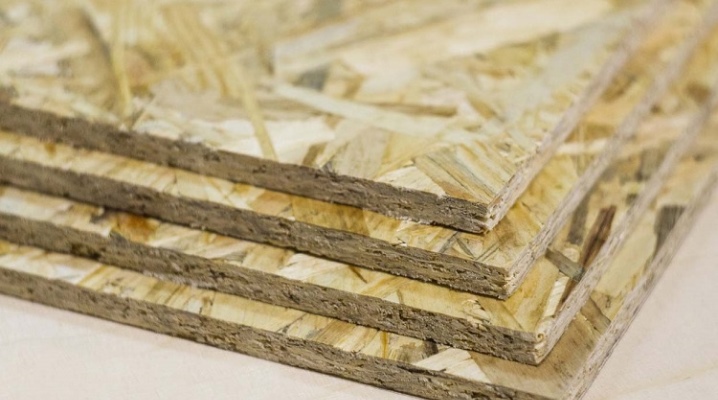
OSB (decoding - oriented strand board) are divided into 4 types: OSB-1, OSB-2, OSB-3 and OSB-4. The first 2 modifications are of the lowest quality, they cannot be used for the construction of load-bearing structures, and also cannot be used in rooms with high humidity. Of all types of materials, OSB-3 is considered the most popular. It has the best price / performance ratio.


What it is?
OSB in English means oriented strand board, which in its abbreviated form sounds like OSB, therefore the Russian abbreviation is sometimes written OSB. It is a structural multilayer material, in the manufacture of which conifers are mainly used. For the production of wood boards, chips are obtained with a length of 8-20 cm. The resulting chips are mixed with a binder, boric acid and resins. The layers of the resulting mass are glued together on pressing equipment under the influence of high temperatures and pressure.
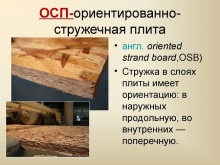


The main difference between OSB and other sawn timber is the difference in chip orientation. Chips in the first and last layer are placed along the length of the entire sheet, and in the middle - in a perpendicular position relative to the covering layers. Unlike OSB-1 and OSB-2, OSB-3 has good water resistance.


OSB-4 has the best technical characteristics and performance, however, due to the high price, the material is unpopular. You can distinguish OSB-3 from others by the ends - European manufacturers often paint the edges to prevent swelling of the material.
Moisture-resistant modifications, unlike conventional ones, can be coated with a film (laminated) or a special varnish.



OSB-3 boards, the description of the merits of which are of interest to many builders, have recently gained great demand. Their popularity is due to a number of advantages:
- light weight, facilitating the transportation and installation of sheets;
- homogeneous structure;
- strong retention of fasteners due to high density;
- ease of use - the material can be sawed, cut and processed with improvised tools;
- the ability to resort to several processing methods - the sheets can be painted in the desired color, varnish applied;
- versatility - OSB can be used for leveling walls, arranging under-roof space or floors, as well as for other construction work.
The disadvantages include low aesthetics, which is why oriented strand boards are practically not used for external cladding. In addition, this lumber is classified as environmentally unsafe and combustible.
It has a 4 hazard class in terms of toxicity - this means that the material releases many harmful substances into the environment during ignition and combustion.

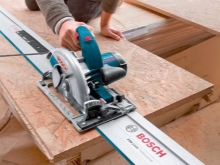

Characteristics and properties
OSB-3 has the same physical and chemical properties over the entire surface. The material is durable, easy to use, resistant to moisture. Unlike natural wood, the boards do not have internal voids and cracks on the surface, holes from fallen knots and other defects. The mechanical and chemical properties of OSB-3 are close to plywood. Let's consider them in more detail.

Environmental friendliness
Many potential consumers of OSB-3 are interested in their harmfulness to humans. The fact is that such building materials are not environmentally friendly and can be hazardous to health. In the production of panels, chemically obtained resins are used as a binder. Most often, manufacturers use phenol-formaldehyde and melamine-formaldehyde compositions. Thanks to the use of these substances, it is possible to increase the strength of the boards and reduce the production cost.

Polymeric binders can harm human health as they release benzene, phenol, formaldehydes and other carcinogenic compounds into the environment. Entering the body in large quantities, they cause skin diseases, allergic rashes, respiratory and vision diseases. To find out the concentration of harmful substances, you need to study the information in the certificate of conformity.
In such documentation, manufacturers indicate information about the research carried out - from them one can reason about the safety of the product.

The formaldehyde emission class is determined by the standards:
- E0;
- E1;
- E2;
- E3;
- E4.
Plates of classes E0-E1 have minimal harm to health. They can be used indoors, as well as for decoration of hospitals and children's rooms. Due to the higher concentration of carcinogenic substances, building materials E2 and E3 are allowed to be used only for outdoor work.



Strength
Depending on the manufacturer, the hardness of OSB-3 may vary slightly. Basically, the slabs are capable of withstanding a load not exceeding 640 kg / m3. Their bending strength relative to the longitudinal axis is 22 N / mm2, and along the transverse axis - 11 N / mm2.

Density
Its indicators are 640-650 kg / m3 (corresponds to the values of coniferous trees). Due to its good density, the building material does not crumble or delaminate during processing and installation of fasteners into it. Due to the use in the production of large chips, the plates are able to reliably hold the hardware even at a minimum distance of 1 cm from the ends. At the same time, chips and other defects from mechanical stress do not form on the sheet.


Moisture resistance
OSB-3 belongs to waterproof boards. They can be used in rooms with high humidity, as well as for outdoor work. The moisture resistance of these building materials is calculated using the coefficient of swelling in thickness. To determine it, a plate of a certain thickness is placed in water for 24 hours.
After this time, swelling of the material is recorded, for OSB-3 the coefficient should not exceed 15%.

Other
OSB-3 sheets have a low vapor permeability equal to 0.0031 mg / (m · h · Pa). It is comparable to the vapor resistance of foam glass. Low rates are achieved due to the use of resins in the production of materials, which, when solidified, do not pass steam well. The sheets have a weak biological stability when they are kept for a long time in conditions of high humidity or with sharp temperature jumps. In dry rooms, the panels are rarely affected by fungal and moldy microorganisms. To increase the biological resistance of OSB-3, it is recommended to use special moisture-protective compounds: varnishes and paints with protective functions.
OSB-3 has good resistance to heat transfer - the material perfectly retains heat inside the room and creates a barrier to cold penetration. Thermal conductivity indicators directly depend on the thickness of the sheets. For example, for a 9 mm panel, the value will be 0.08 W / (m K), and 18 mm - 0.16 W / (m K).

Sheet sizes
Domestic and foreign manufacturers offer OSB boards of various sizes. The thickness of the products is (in mm):
- 6;
- 8;
- 9;
- 10;
- 12;
- 15;
- 16;
- 18.

Some manufacturers offer extra strong and rigid panels with a thickness of 22 and 30 mm. Popular sheet sizes (in mm):
- 2500x1250x10;
- 2500x1250x15;
- 12x1250x2500;
- 9x1250x2500;
- 18x1250x2500;
- 18x1220x2440.
The weight of 1 sheet depends on the size of the material. For panels of standard sizes, it ranges from 12 to 45 kg. When choosing the size of OSB-3 for cladding surfaces, it is best to give preference to dimensional sheets, for example, 3000x1500 mm - in this way it will be possible to reduce the number of joints.

Popular manufacturers
The assortment of oriented strand boards is represented by products of domestic and European production. The rating of popular brands includes the following companies: Kronospan, Bolderaja, Glunz, Kalevala, Ultralam, EGGER, Izoplat, Arbec.
- The Kronospan brand was founded in Latvia. With the increase in production capacity, its branches began to open in Romania, Belarus and Russia. High quality materials with E1 emission class are produced under this trade mark. The manufacturer offers products with a smooth outer and rough inner side, which provides a more convenient installation of building materials.

- According to consumers, the most popular Latvian OSB manufacturer is Bolderaja. This is one of the largest European woodworking companies. Bolderaja board materials are distinguished by good physical and chemical characteristics and operational properties. OSB-3 are produced with flat ends or T & G-4 “thorn-groove” type. Extra strong panels with a thickness of 30 mm are available for sale.

- Glunz is a large German manufacturer of OSB-3, which has united the Sonae Industria group of companies. Under this brand, safe for health cookers with an emission class E0 are produced.
In the production of oriented strand board, the manufacturer uses carefully selected raw materials and environmentally friendly binders.

- "Kalevala" Is the next largest manufacturer of high-quality tile materials, with production facilities located in Russia. For the manufacture of OSB, he uses Karelian wood, which is famous for its high strength indicators, due to which the density of finished sheets is up to 700 kg / m3. Due to the excellent quality, the products of this brand have gained popularity not only in Russia, but also in the CIS countries.

- Another reliable domestic manufacturer of OSB-3 is Ultralam. It offers tile materials with the best value for money. Ultralam boards are manufactured using continuous pressing technology. Plates of this brand are distinguished by ideal geometry and high density indicators - not less than 620 kg / m3.

- Under the EGGER brand slabs with low hygroscopicity of the E0 and E1 standards are produced, which makes them in demand for interior decoration.

- Plates brand "Isoplat" differ in physical characteristics from OSB-3 of the above manufacturers. They are less dense and more loose. Such panels are weighty. However, they also found their customers due to the budgetary cost and the provision of good thermal and sound insulation.

- Arbec entered the rating of the best OSB manufacturers. This is a Canadian trade mark, under which OSBs are produced with increased water resistance, good thermal insulation and the best noise absorption.

Areas of use
OSB-3 is allowed to be used both indoors and outdoors. They are widely used for the following types of work:
- when constructing roof sheathing;
- for cladding interior and exterior walls of the house;
- when arranging rough floors (for leveling the surface for laminate, linoleum, parquet board or other facing materials);
- when finishing ceiling surfaces;
- when erecting landings and stairs;
- for the installation of floors, I-beams;
- to create supporting structures for various finishing materials;
- for formwork during the construction of the foundation;
- when arranging floors in trucks.
OSB-3 can be used in furniture production. In the manufacture of furniture items, they are used to create parts that are planned to be subjected to high loads. Oriented strand sheets are often used to make shipping crates, billboards, production racks and shelves.
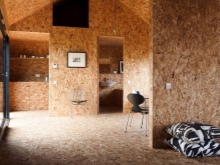

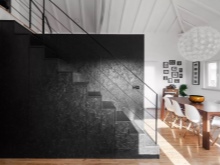
Selection Tips
In hardware stores, OSB-3 is sold in a wide range, which makes it difficult for the consumer to choose a quality product.
- When buying a tile material, you must first of all pay attention to the class of emission of harmful substances. For the manufacture of furniture and interior decoration, it is recommended to choose OSB E0 or E1. E2 slabs are suitable for outdoor work. It is best to refuse products with emission class E3.
- When choosing the thickness of the sheet, you need to take into account the type and intensity of the expected loads, the distance between the supporting structures, as well as the load-bearing parameters of the slab.
- For roofing work, it is best to give preference to panels with a corrugated or rough side. It allows you to obtain a good degree of adhesion to bituminous primers and mastics. For exterior decoration, laminated sheets or OSB-3 coated with varnish are suitable. Panels with such coatings resist moisture better, due to which they are recommended for use in rooms with high humidity.
- When choosing plates, you need to take into account their smell. You should refuse to purchase products that exude a pungent smell of formalin or plastic - it indicates a high toxicity of the product.
- Before buying, you need to ask for a certificate of conformity for the purchased building materials and other related documentation. And also, if possible, inspect the packaging - it should be intact, without breaks. Reliable manufacturers complete slab lumber with inserts, which indicate the product labeling and its physical and chemical properties.

Features of installation and use
Installation of OSB-3 does not require special skills. For fixing the plates, it is allowed to use various fasteners: nails, self-tapping screws, rivets or screws. In addition, materials can be glued together with special wood compounds. When choosing an adhesive, it is necessary to take into account the load on the surface, the degree of humidity during operation, as well as the required degree of connection. For internal work, non-toxic substances should be selected.
Installation recommendations for flooring:
- materials with straight ends are laid with a gap of 3-4 mm; when arranging a floating floor, the gap between the sheet and the wall should be at least 12 mm;
- the connection of the short edges must be carried out along the lags, and the long ones - using the thorn-groove connection;
- the panels should be fixed with nails; for a more reliable fixation, you need to apply glue between the OSB and the logs.

When laying floors in open areas, it is necessary to protect the cladding from moisture - for this, it can be additionally covered with specialized moisture-protective compounds. If the coating will be exposed to rain, it is recommended to provide a drainage system and a waterproofing layer. When mounting the panel using screws, it is recommended to pre-make holes in it.
To achieve the desired results, do not use wet panels. If the materials have been exposed to rain, they must be treated with anti-biological corrosion compounds and wait for the sheets to dry.
OSB-3 is a multifunctional building material. It is used in various fields, on which the features of installation work will depend.














The comment was sent successfully.